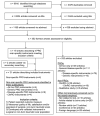Patient-Reported Outcome Instruments for Surgical and Traumatic Scars: A Systematic Review of their Development, Content, and Psychometric Validation
- PMID: 27357634
- PMCID: PMC5505642
- DOI: 10.1007/s00266-016-0642-9
Patient-Reported Outcome Instruments for Surgical and Traumatic Scars: A Systematic Review of their Development, Content, and Psychometric Validation
Abstract
Background: Patient-reported outcomes (PROs) are of growing importance in research and clinical care and may be used as primary outcomes or as compliments to traditional surgical outcomes. In assessing the impact of surgical and traumatic scars, PROs are often the most meaningful. To assess outcomes from the patient perspective, rigorously developed and validated PRO instruments are essential.
Methods: The authors conducted a systematic literature review to identify PRO instruments developed and/or validated for patients with surgical and/or non-burn traumatic scars. Identified instruments were assessed for content, development process, and validation under recommended guidelines for PRO instrument development.
Results: The systematic review identified 6534 articles. After review, we identified four PRO instruments meeting inclusion criteria: patient and observer scar assessment scale (POSAS), bock quality of life questionnaire for patients with keloid and hypertrophic scarring (Bock), patient scar assessment questionnaire (PSAQ), and patient-reported impact of scars measure (PRISM). Common concepts measured were symptoms and psychosocial well-being. Only PSAQ had a dedicated appearance domain. Qualitative data were used to inform content for the PSAQ and PRISM, and a modern psychometric approach (Rasch Measurement Theory) was used to develop PRISM and to test POSAS. Overall, PRISM demonstrated the most rigorous design and validation process, however, was limited by the lack of a dedicated appearance domain.
Conclusions: PRO instruments to evaluate outcomes in scars exist but vary in terms of concepts measured and psychometric soundness. This review discusses the strengths and weaknesses of existing instruments, highlighting the need for future scar-focused PRO instrument development.
Level of evidence iv: This journal requires that authors assign a level of evidence to each article. For a full description of these Evidence-Based Medicine ratings, please refer to Table of Contents or the online Instructions to Authors www.springer.com/00266 .
Keywords: Cicatrix; Instrument; Measure; Patient-reported outcome; Quality of life; Scar; Systematic review.
Figures
References
-
- Weiser TG, Regenbogen SE, Thompson KD, Haynes AB, Lipsitz SR, Berry WR, Gawande AA. An Estimation of the Global Volume of Surgery: A Modelling Strategy Based on Available Data. Lancet. 2008;372:139–144. - PubMed
-
- Brown BC, Mckenna SP, Siddhi K, Mcgrouther DA, Bayat A. The Hidden Cost of Skin Scars: Quality of Life after Skin Scarring. Journal of Plastic, Reconstructive & Aesthetic Surgery: JPRAS. 2008;61:1049–1058. - PubMed
-
- Kinahan KE, Sharp LK, Seidel K, Leisenring W, Didwania A, Lacouture ME, Stovall M, Haryani A, Robison LL, Krull KR. Scarring, Disfigurement, and Quality of Life in Long-Term Survivors of Childhood Cancer: A Report from the Childhood Cancer Survivor Study. J Clin Oncol. 2012;30:2466–2474. - PMC - PubMed
-
- Sullivan T, Smith J, Kermode J, Mciver E, Courtemanche DJ. Rating the Burn Scar. J Burn Care Rehabil. 1990;11:256–260. - PubMed
-
- Beausang E, Floyd H, Dunn KW, Orton CI, Ferguson MW. A New Quantitative Scale for Clinical Scar Assessment. Plast Reconstr Surg. 1998;102:1954–1961. - PubMed
Publication types
MeSH terms
Grants and funding
LinkOut - more resources
Full Text Sources
Other Literature Sources
Medical
Research Materials
Miscellaneous


